Samsung QE65QN94A Review
The QN94A delivers spectacularly bright 4K HDR picture quality
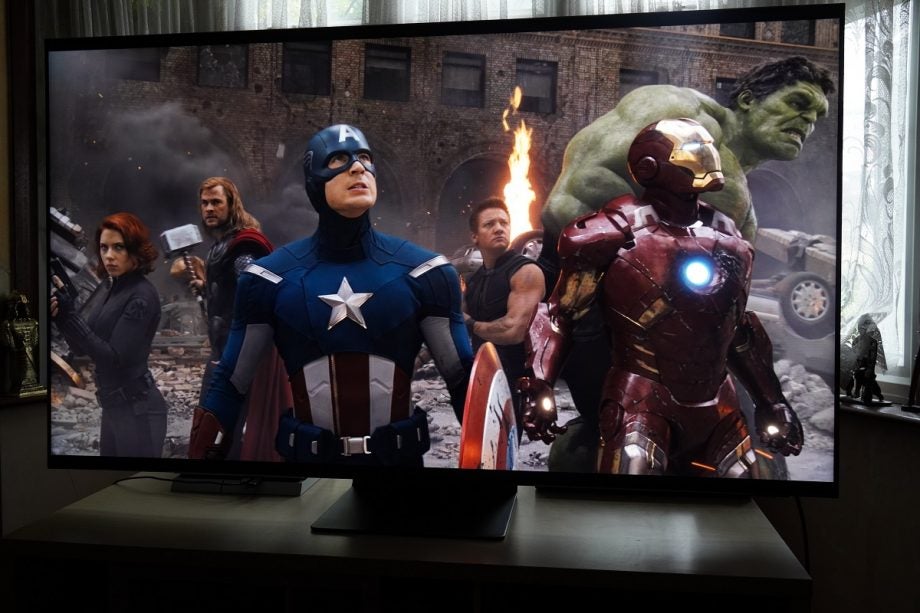

Verdict
With its Mini-LED backlight, Samsung’s Neo QLED is a light canon with 4K HDR content. Beautifully made, with a wide range of gaming features, the QN94A delivers excellent OLED-like black levels and terrific picture quality.
Pros
- Super bright 4K HDR performance
- Fast gaming performance
- Excellent build quality
- Solid app selection
Cons
- Proper expensive
- No Dolby Vision/Atmos decoding
- Not the most convincing motion
Key Features
- Quantum Mini-LED backlightFeatures Samsung’s latest backlight technology for even higher brightness
- Class-leading latencyDelivers the fastest latency for gaming consoles/PC
- HDRSupports HDR10, HLG and HDR10+ Adaptive formats
Introduction
Samsung’s 2021 QLED range marks the biggest refresh of its TVs in some time with the addition of the Mini–LED backlighting.
Despite a recent thawing in relations, and even rumours that Samsung was looking to purchase OLED TV displays from LG, you get the sense that Samsung isn’t fond of OLED.
So the QN94A Neo QLED, armed with its Mini-LED backlighting technology, aims to not only justify why Samsung considers its QLED tech to be the best, but to beat OLED at its own game.
Samsung is pushing its chips onto the table with a confident hand. Does the Samsung QE65QN94A Neo QLED 4K TV have a winning one, though?
The QN94A is exclusive to the UK market, with Samsung offering three variants with similar specs (QN95A and QN90A).
Spec-wise, there’s little difference between it and the QN95A we’ve already reviewed, other than it doesn’t have the One Connect box and sheds a few hundred pounds in the process.
Design
- Minimalist looks
- Excellent build quality
- Features anti-reflective screen tech
Another year, another Samsung QLED – and another very similar-looking TV. While it’s all-change internally, the outward appearance is virtually identical to previous models. It’s another high-quality, minimalist set built to the highest standards.
Samsung encourages comparisons with OLED TVs, given most OLED sets aren’t as slim as the marketing suggests. At 25.9mm, it will pretty much sit flush against a wall, but LG has gazumped Samsung’s Neo QLEDs with a depth of 23.1mm.

Regardless, the QN94A has the same depth as the QN95A model that comes with the external One Connect box. In the past, the One Connect box indicated the TV was slimmer than its similarly attired cousins. While that’s not the case here, the One Connect box does bring meaningful differences that I’ll get to later on.
The stand that supports the QN94A is one of the heaviest things I’ve lifted. If you’re inclined to wall-mount this set, I’d suggest putting the stand together anyway and using it for home workouts. It’s that heavy.

There’s a slight tilt backwards to the screen that’s only noticeable from the side. It isn’t an issue and works out for the best given you wouldn’t want the screen to lean forward, lest it tip over.
Samsung has moved its branding towards the side to firm up the set’s minimalist tastes, while the bezel that frames the screen gives full prominence to the images the TV (spoiler alert) rather wonderfully creates.
The screen also supports Samsung’s Anti-Reflective technology. To my eyes, I’d say it minimises the intensity of reflections better than the Q95T. With bright lights there’s a slight reflection, but for the most part, watching in a bright room offered few distractions.
Interface
- UK catch-up apps supported
- Samsung TV Plus free content boosted
- New ‘smart’ remote
Unlike LG’s webOS 6.0, Samsung hasn’t overhauled its Tizen 6.0 OS. Nips and tucks are evident as the OS promotes features better than the 2020 models.

The Tizen/Eden-based interface covers most of the major apps such as Apple TV, BT Sport, Spotify, Netflix, Amazon Prime Video and Disney+. A few are left out, such as Tidal and the fitness-focused Peloton (I’m sure Samsung will argue its Health app is an adequate alternative). In terms of sheer number it’s bested by Google TV, and Samsung doesn’t have as many exclusives anymore – but the coverage and breadth of what’s on offer is enough for most.
Samsung doesn’t support Freeview Play, but all the UK catch-up apps are present. In addition, Samsung is pushing its TV Plus service with its integrated electronic programme guide as an alternative to Freeview. Like Freeview, it’s free to watch and requires no subscription.
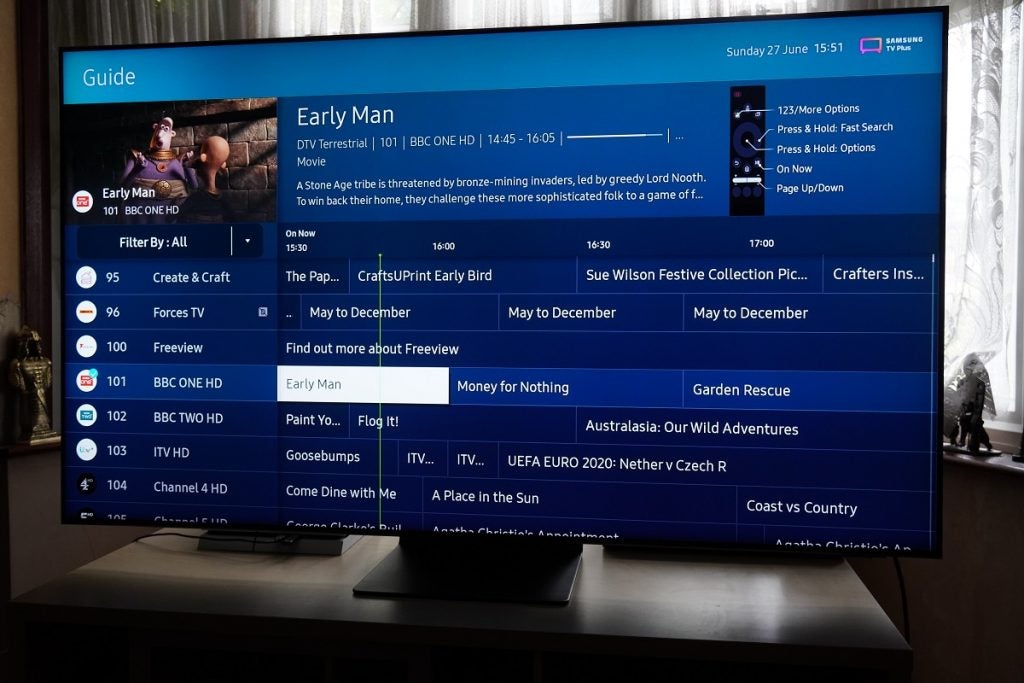
TV Plus also curates content from a number of apps and services (even UKTV), and there’s an okay selection of movies and TV series that sashays from good (Haywire, Natural Born Killers) to iffy (recent John Travolta and Nicolas Cage films). There’s also a channel seemingly devoted to Baywatch reruns.
Multi-View returns and actually has a prominent space in the Smart Hub. Like its implementation on the 2020 TVs, you can watch multiple sources simultaneously (the QN94A supports two screens) – an example being watching the news while casting a fitness video in the other window.


The feature has evolved to create presets you can easily summon. It doesn’t work with all video streaming apps (iPlayer for one) and reverts to Multi-View whenever content is ‘cast’ to the QN94A, which can be annoying.
Samsung continues to supply two remotes – a standard model and a less cluttered, more ergonomic version with volume and channel rockers. The latter is the preferred remote; it’s nice, simple and intuitive to use, and has undergone an eco-minded redesign for 2021.

Turn it over and there is – for lack of a better term – a solar panel that allows the remote to charge itself by soaking up ambient light. Quick access buttons include the usual suspects in Netflix and Prime Video, while Samsung’s TV Plus replaces Rakuten TV.

Features
- Class-leading latency
- Only one HDMI 2.1 input
- Multi-View offers multi-screen action
There’s the same breadth of features packed into the QN94A we’ve come to expect from premium Samsung TVs over the past few years.
Intelligent modes adapt picture and audio by recognising the content playing as well as the environment around the TV. They include Adaptive Picture, Adaptive Sound+, Active Voice Amplifier and Adaptive Volume. You can toggle each one on/off in the settings, and out of the bunch I’d say Adaptive Sound+ is worth a go, but the others aren’t wholly necessary. In particular Adaptive Picture, which can either subtly change brightness and colours or drastically affect them.

In terms of digital assistants, Samsung has included Amazon Alexa and Google Assistant from the off, alongside Samsung’s own Bixby.

Filmmaker mode returns, continuing to reassure Hollywood creatives you’re watching their films in the manner they want by disabling the TV’s processing. It and the Movie mode are the most accurate options, so if you want the best picture with calibration, either of these two will hit the spot.
From a gaming perspective Samsung has been usurped by LG in terms of feature count, but when it comes to latency Samsung is still at the head of the class. Latency at 1080p was 9.4ms and 9.1ms at 4K. Since the QN94A supports refresh rates up to 120Hz, its optimum performance could feasibly drop much, much lower.
Samsung’s alternative to LG’s Game Optimiser is apparent in its Game Bar. It fulfils a similar function by giving gamers quick access to settings and information such as frames per second, HDR support and latency in a bar at the bottom of the screen. It can be called up by pressing the play/pause button on the ‘smart’ remote.
The Super UltraWide Game View stretches the image to either 21:9 and 32:9 screen ratios and is only possible when a PC/laptop is connected. And you’d also need to be sitting fairly close to the screen for the required effect.
Game Motion Plus improves image quality, but is better suited for games that aren’t fast-twitch or have a more competitive element to them. Latency here is still better than the majority of TVs (13.7ms at 1080p/13.9ms at 4K), so you’re not losing much. HGiG HDR for improved tone-mapping/picture quality with supported games is also touted.
The Samsung QN94A supports ALLM (Auto Low Latency Mode) for automatically switching to the TV’s lowest latency mode, VRR (Variable Refresh Rate) for matching the TV’s refresh rate to the console/PC for less tearing and stutter, while High Frame Rate goes all the way to 4K/120Hz. Only the HDMI 4 – the ‘game’ input as it were – supports these features, however.
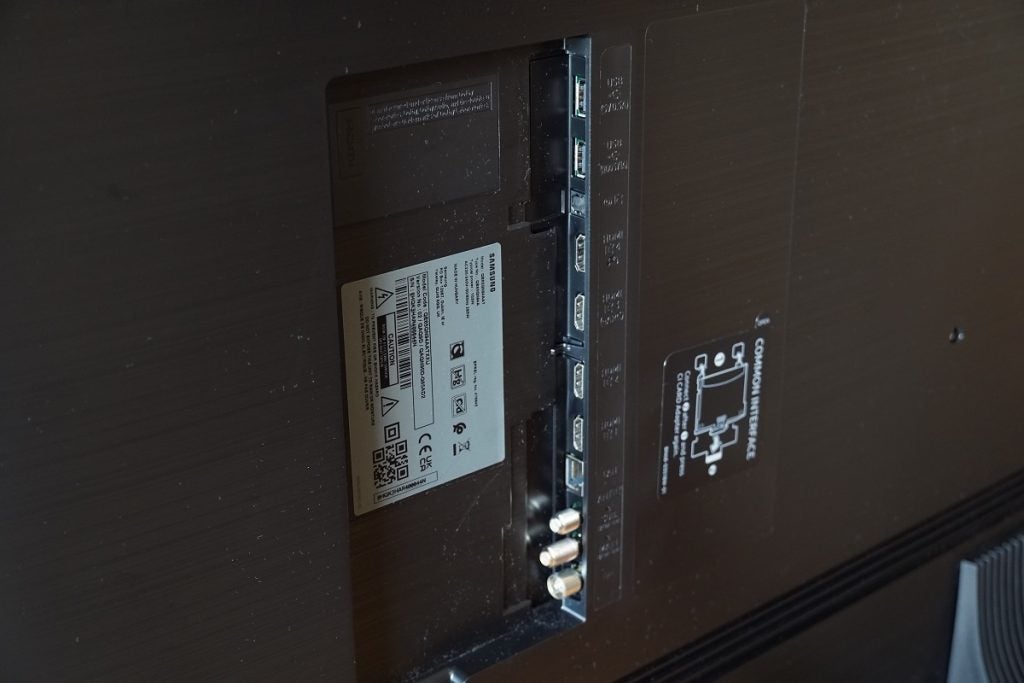
This is where the difference between the QN94A and QN95A is most evident. The slimline One Connect external box supports HDMI 2.1 (ALLM, VRR, HFR) across all its HDMI inputs, so you can plug a Xbox Series X and a PS5 into any of the QN95A’s HDMI inputs. As Samsung continues to give Dolby Vision the widest of berths, Dolby Vision for Gaming isn’t coming to their TVs any time soon.
Connections tally at four HDMI (HDMI 3 supports eARC for passing high-quality audio to soundbars), Ethernet, optical, a CI+ 1.4 connection, 2 x satellite tuners, as well as an aerial one and two USB 2.0 ports. Bluetooth 5.2 as well as Wi-Fi and DLNA compatibility are onboard.
Picture quality
- Incredibly bright
- Excellent black levels
- Impressive upscaling
The addition of the Quantum Mini-LED backlight works wonders. The Samsung QE65QN94A is a showcase for bright, eye-popping contrast and 4K HDR performance.
But it’s equally adept with upscaling lower-quality sources. While the QN94A doesn’t boast the advanced neural network upscaling of the 8K models, its upscaling offers an excellent sense of fine detail, clean and healthy-looking colours, and sharply etched lines that bring out more definition with HD sources.
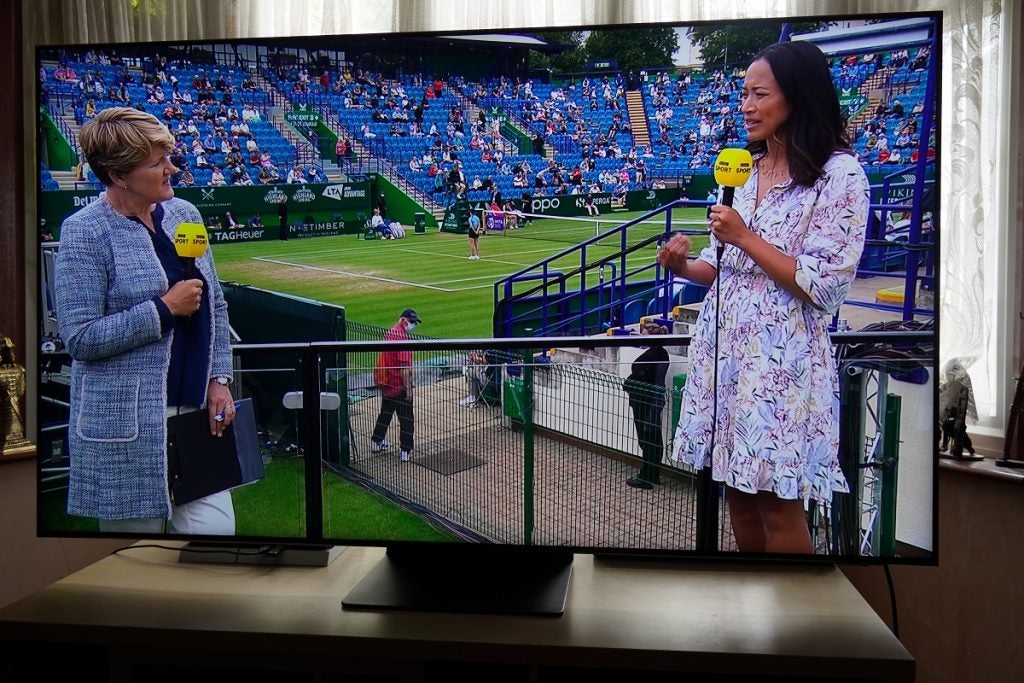

Standard definition content predictably suffers from a lack of sharpness, detail and clarity. Noise is prevalent, although not particularly distracting with SD content, and both HD and SD sources benefit from the QN94A’s brightness and wide colour output. I’d argue LG’s upscaling tech wrings more detail from faces in SD content, but this is nevertheless a very consistent performance.
SD SDR – – – – – – – – – – – – – – – – – – – – – – – – – – – – – – – HD SDR
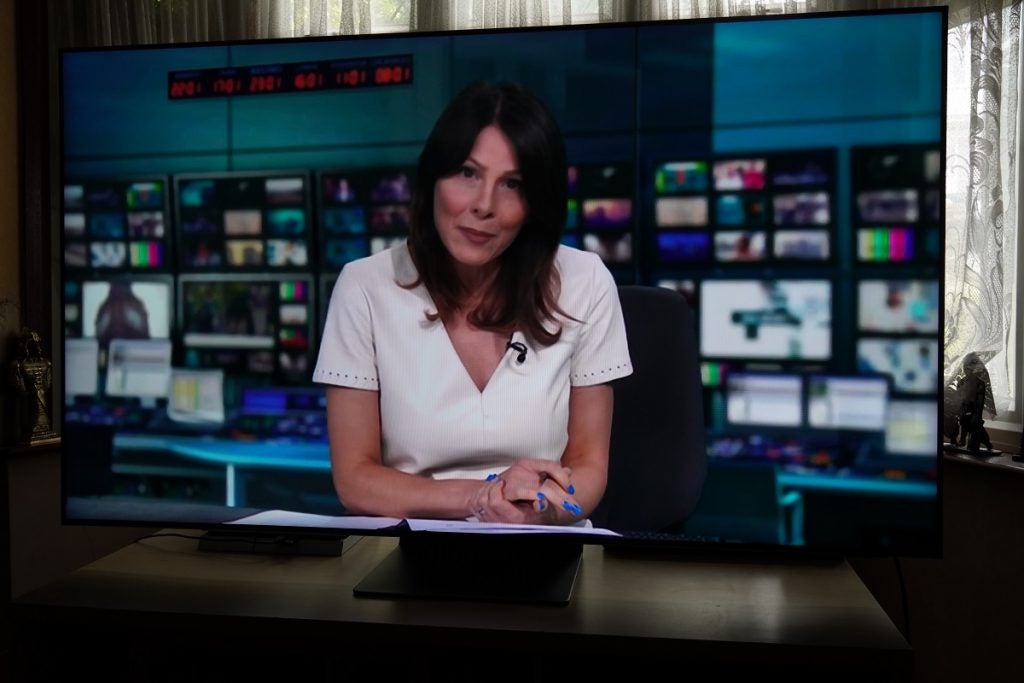
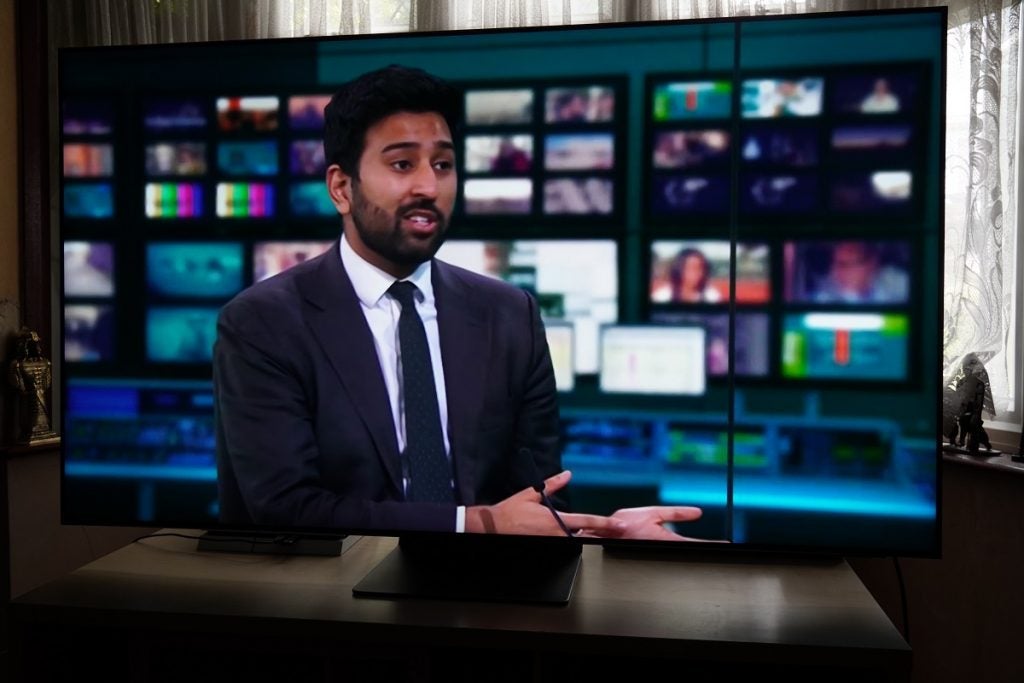

I’m less convinced about its ‘Picture Clarity’ motion processing. Samsung doesn’t offer a wealth of options: simply Auto, Custom and Off. Auto is the least distinguished since it induces judder and a slight shimmer and frayed edges, which can distract with sports.
Custom allows for manually setting De-Blur and De-Judder settings as well as fiddling with noise reduction. De-Blur and De-Judder are set to 10 and 3, but to my eye there’s no difference between having this option on or off. If there is an effect then it’s very slight.
The local dimming system consists of 792 dimming zones and its precision is impressive. Watching films, bright objects close to the top and bottom black bars exhibit no bleed, while bright HDR objects displayed no blooming either. The only noticeable blooming was when I brought up the playback status bars on a predominantly black screen.
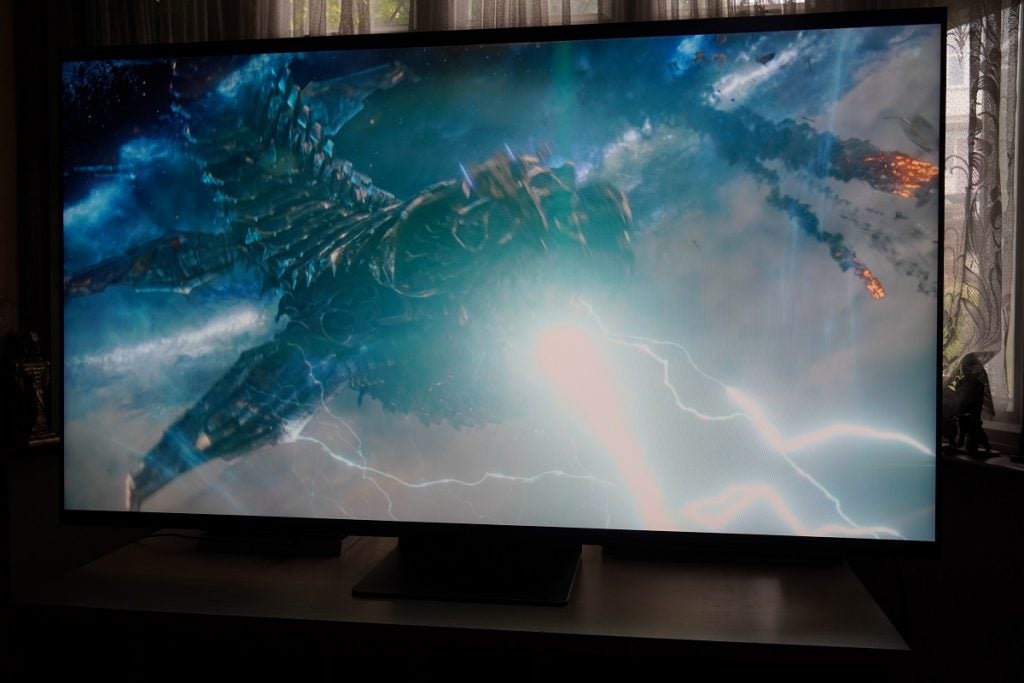
The issue with the 2020 models, where brightness of small objects was reduced, isn’t observed here; so the scene where Chris falls into the Sunken Place maintains the same, consistent brightness throughout. Samsung’s dimming algorithms aren’t quite as sophisticated with subtitles, with some words bright and others less so.
There’s a case to be made that its brightness overpowers the image. Game Mode is very bright – with my PS4’s yellow background, I actually squinted when the console booted up. Skimming through a few channels, I noticed that switching between Low and Standard dimming could turn an overcast shot of clouds into a bright-looking day.
Samsung offers a choice of Dynamic, Natural, Standard, Movie and Filmmaker picture modes. The latter two are the most accurate with little, if any, difference between them.
Dynamic is the more lurid option, with its blue tint but bolder and more vivid colours, while Natural exacerbates greens and whites, and Standard is the most balanced out of the three. Standard isn’t as punchy as Natural, which I feel is more suited to sports – but I prefer a more balanced and natural-looking image.
With 4K HDR content, the Samsung QN94A moves into overdrive. Highlights are incredibly bright but don’t sacrifice detail. The QN94A delivers some of the punchiest, vibrant and colourful 4K HDR images I’ve seen.

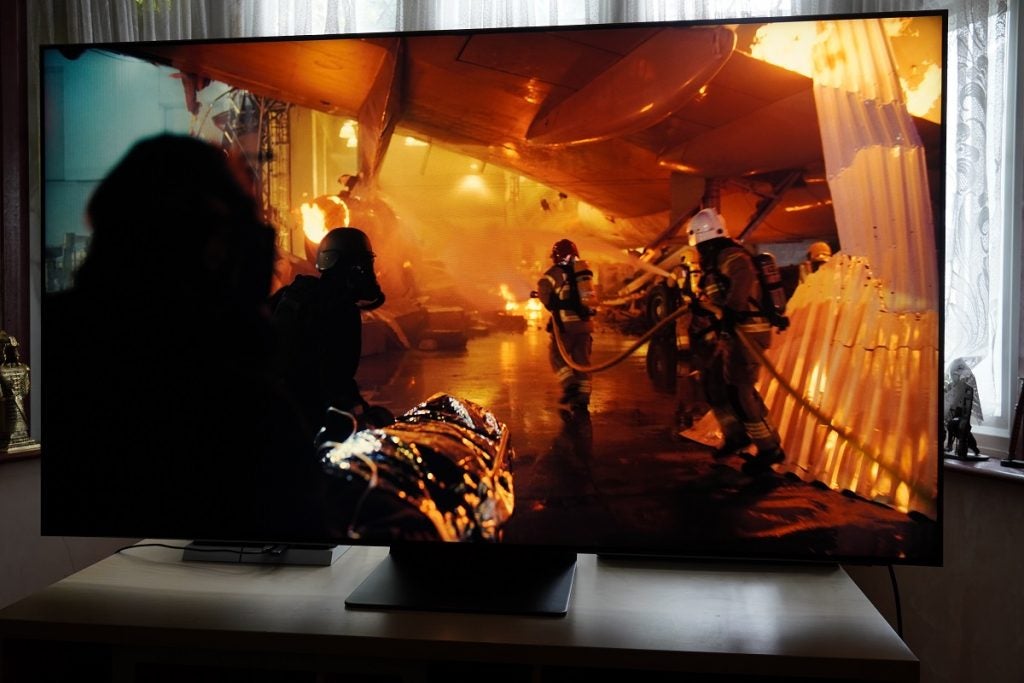
And it does so while producing black levels very close to OLED. Images pop with a three-dimensionality; whites are intensely conveyed, with colours wide-ranging, bold and expressive in look. Feed it as much 4K HDR content from any source and the Samsung QN94A delivers on the promise of HDR. Wide angles are also impressive, retaining saturation and colour depth in a similar manner to OLED TVs.


This Samsung also has a knack for nailing the texture and quality of objects, characters and surfaces, with a very sure hand in a series such as Black Narcissus (4K HLG) on iPlayer or with the combined 70mm/IMAX scenes in Tenet (4K HDR). The QN94A’s sense of contrast helps the TV to output some gorgeously natural but vivid images.
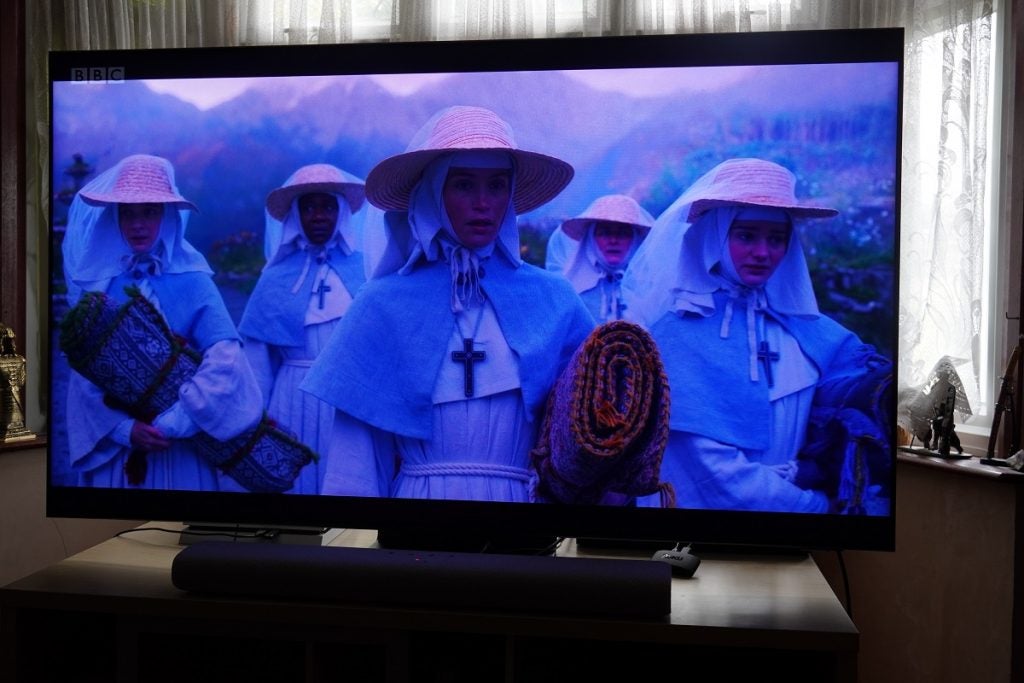

There’s no Dolby Vision HDR, but I do wonder whether it’s absolutely necessary with this level of brightness. Watching the opening of John Wick: Chapter 3 – Parabellum, there didn’t appear to be a huge amount of difference between it and the LG G1 OLED’s Dolby Vision performance.
Given Dolby Vision’s continued absence (I imagine Samsung doesn’t like its idea of picture quality dictated to them), you could view that as a win for LG since it can hit similar levels with less brightness. But not everything is in Dolby Vision, and the Samsung’ s high brightness means even standard HDR10 content is rendered in terrifically bright fashion.
Sound quality
- Clear and detailed sound
- No onboard Dolby Atmos decoding for apps
- Flat soundstage
The Samsung QE65QN94A’s sound system is surprisingly impactful. I’d still suggest partnering it with a capable sound system – potentially, a Samsung soundbar given the shared traits and technology – but it holds its own fairly well. Continuing Samsung’s lack of Dolby support, the QN94A doesn’t appear to decode Atmos from streaming apps.
The TV only deals with Standard and Amplify sound modes, but it delivers a big and loud sound that’s free from harshness. The 60W OTS+ – Object Tracking Sound+ – system can track objects across the screen for more accurate placement and ‘steering’ of effects.
It’s sharp, but not excessively so, and detailed and clear with broadcast content. And while it is a predictably flat soundstage, enabling Adaptive Sound+ in the settings increases the width, as well adding more heft to a scene in Tenet where a building simultaneously explodes and is reconstituted back together.

There’s a good sense of space, too, with the OTS+ system placing sounds towards the top and bottom of the screen as Thanos’ hordes attack Wakanda in Infinity War. Flicking on the Amplify mode gives it a bigger, louder tone, but you can’t escape how flat the soundstage feels.
Dialogue is crisply delivered and easily decipherable, although there’s a flatness to it and so it lacks emotion. Bass is decent, but is obviously missing depth and extension. The QN94A sports a very competent sound system for a TV, but matching it with a soundbar will add an extra dimension.
Should you buy it?
For bright, expressive picture quality full of contrast Armed with its Mini-LED tech, the QN94A delivers a consistently bright performance for some of punchiest, colourful images you’ll see in a TV in 2021.
This Neo QLED TV doesn’t come cheap With an RRP of £2899 – although it has dropped in price since launch – this TV is obviously very expensive and will be beyond most people’s purse strings.
Verdict
With its Mini-LED backlight, Samsung’s Neo QLED is a light canon with 4K HDR content. Beautifully made, with a wide range of gaming features, the QN94A delivers excellent OLED-like black levels and terrific picture quality. It’s expensive, but also very impressive.
FAQs
No, this TV does not feature support for Dolby Vision. It supports HDR10, HLG, HDR10+ and HDR10+ Adaptive
The Neo QLED branding refers to Samsung TVs that feature its Mini LED backlight technology.
The Samsung QE65QN94A is not certified for G-Sync by Nvidia, but it does work with G-Synch compatible graphics cards.








